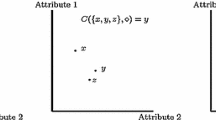Abstract
Transitivity is a compelling requirement of rational choice, and a transitivity axiom is included in all classical theories of both individual and group choice. Nonetheless, choice contexts exist in which choice might well be systematically intransitive. Moreover, this can occur even when the context is transparent, and the decision maker is reflective. The present paper catalogues such choice contexts, dividing them roughly into the following classes:
-
1.
Contexts where the intransitivity results from the employment of a choice rule which is justified on ethical or moral grounds (typically, choice by or on behalf of a group).
-
2.
Contexts where the intransitivity results from the employment of a choice rule that is justified on economic or pragmatic grounds (typically, multi-attribute choice).
-
2.
Contexts where the choice is intrinsically comparative, namely, where the utility from any chosen alternative depends intrinsically on the rejected alternative(s) as well (typically, certain competitive contexts).
In the latter, independence from irrelevant alternatives may be violated, as well as transitivity. However, the classical money-pump argument against intransitive choice cycles is inapplicable to these contexts. We conclude that the requirement for transitivity, though powerful, is not always overriding.
Similar content being viewed by others
References
Arrow, K. J.: 1951, Social Choice and Individual Values, New York: Wiley.
Bell, D. E.: 1982, ‘Regret in Decision Making under Uncertainty’, Operations Research, 961–981.
Bell, D. E., Raiffa, H., and Tversky, A.: 1983, ‘Normative, Descriptive and Prescriptive Interactions’, Harvard, unpublished manuscript.
Blyth, C. R.: 1972, ‘Some Probability Paradoxes in Choice from among Random Alternatives’, Journal of the American Statistical Association 67, 366–373.
Dummet, M. C.: 1984, Voting Procedures, Oxford: Clarendon Press.
Fishburn, P. C.: 1970, ‘The Irrationality of Transitivity in Social Choice’, Behavioral Science 15, 119–123.
Fishburn, P. C.: 1982, ‘Nontransitive Measurable Utility’, Journal of Mathematical Psychology 26, pp. 31–67.
Fishburn, P. C.: 1984, ‘SSB Utility Theory: An Economic Perspective’, Mathematical Social Science 8, 63–94.
Lindman, H. R. and Lyons, J.: 1978, ‘Stimulus Complexity and Choice Inconsistency among Gambles’, Organizational Behavior and Human Performance 21, 146–159.
Loomes, G. and Sugden, R.: 1982, ‘Regret Theory: An Alternative Theory of Rational Choice under Uncertainty’, The Economic Journal 92, 805–824.
Luce, R. D. and Raiffa, H.: 1957, Games and Decisions, New York: Wiley.
MacCrimmon, K. R. and Larsson, S.: 1979, ‘Utility Theory: Axioms Versus “Paradoxes”’, in M. Allais and O. Hagen (eds.), Expected Utility Hypotheses and the Allais Paradox, Dordrecht, Holland: D. Reidel.
May, K. O.: 1954, ‘Intransitivity, Utility, and the Aggregation of Preference Patterns’, Econometrica 22, 1–13.
Pratt, J. W.: 1972, ‘Comment’, Journal of the American Statistical Association 67, 378–379.
Sage, A. P. and White, E. B.: 1983, ‘Decision and Information Structures in Regret Models of Judgment and Choice’, IEEE Transactions on Systems, Man and Cybernetics 13 (3), 136–145.
Samuelson, P. A.: 1948, ‘Consumption Theory in Terms of Revealed Preference’, Economica, N.S., 15.
Simon, H. A.: 1957, Models of Man, New York: Wiley.
Slovic, P. and Lichtenstein, S.: 1983, ‘Preference Reversals: A Broader Perspective’, The American Economic Review 73 (4), 596–605.
Slovic, P. and MacPhillamy, D.: 1974, ‘Dimensional Commensurability and Cue Utilization in Comparative Judgment’, Organizational Behavior and Human Performance 11, 172–194.
Suppes, P. C.: 1958, Introduction to Logic, Princeton, N. J.: D. Van Nostrand.
Tversky, A.: 1969, ‘Intransitivity of Preferences’, Psychological Review 76, 31–48.
Tversky, A. and Kahneman, D.: 1986, ‘Rational Choice and the Framing of Decisions’, The Journal of Business 59 (4), 251–278.
Tversky, A., Sattath, S., and Slovic, P.: 1987, ‘Contingent Weighting in Judgment and Choice’, unpublished manuscript.
Ullman-Margalit, E. and Morgenbesser, S.: 1977, ‘Picking and Choosing’, Social Research 44 (4), 757–785.
Author information
Authors and Affiliations
Additional information
We wish to thank the colleagues and students, too many to list, with whom we have discussed the ideas in this paper, and in particular to acknowledge our heavy intellectual debt to Amos Tversky, who helped and inspired us in all stages of this study.
Rights and permissions
About this article
Cite this article
Bar-Hillel, M., Margalit, A. How vicious are cycles of intransitive choice?. Theor Decis 24, 119–145 (1988). https://doi.org/10.1007/BF00132458
Issue Date:
DOI: https://doi.org/10.1007/BF00132458




